Chances are you’re acquainted with the starling. This bird with the white-specked breast and dark plumage is common in a variety of habitats around the world.
For such large flocks to sustain themselves so many diverse places, they must have a very adaptable diet. So, what do starlings eat?
These birds are omnivores. They can and will eat anything their beak can get into. However, they have a strong preference for insects as long as there’s enough to go around.
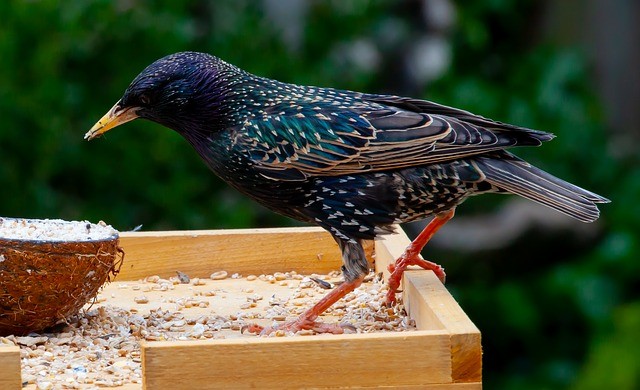
Native to Europe, starlings also thrive in great numbers in North America, where they are considered to be an invasive species.
This is because of the damage they can do to lawns and crops, which is also related to their wide-ranging diet.
Insects & Other Invertebrates
Starlings may be omnivorous, but you’re forgiven for thinking they are strict insectivores. Roughly 58% of the adult starling’s diet is made up of insects and other invertebrates.
For the newly fledged crowd, that percentage ranges from 95-100%.
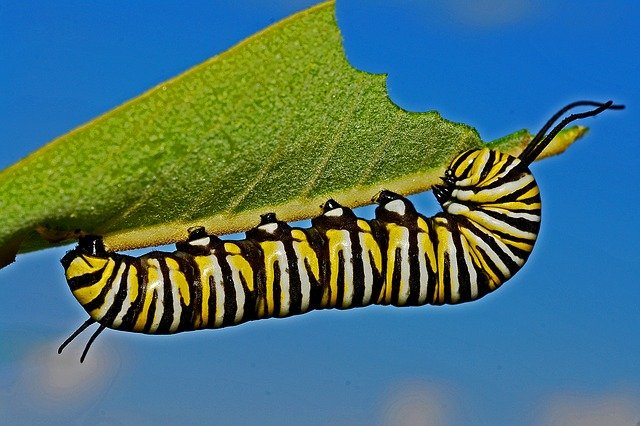
Their appetite for these boneless, bite-sized critters is voracious. No bug is safe, though starlings aren’t indiscriminate eaters. Their targets are plentiful and most nourishing.
What Insects & Invertebrates do Starlings Eat?
Starlings will eat the following insects and invertebrates…
- Beetles
- Caterpillars
- Crickets
- Grasshoppers
- Flies
- Moths
- Bees
- Weevils
- Wireworms
- Earthworms
- Spiders
- Snails
- Mealworms
- Millipedes
Despite their dubious reputation as pests that wreak havoc on crops, research suggests that they may be better thought of as pest control.
Starling flocks dine heavily upon damaging insects, like clover-leaf weevils, leaf beetles, and Japanese beetles.
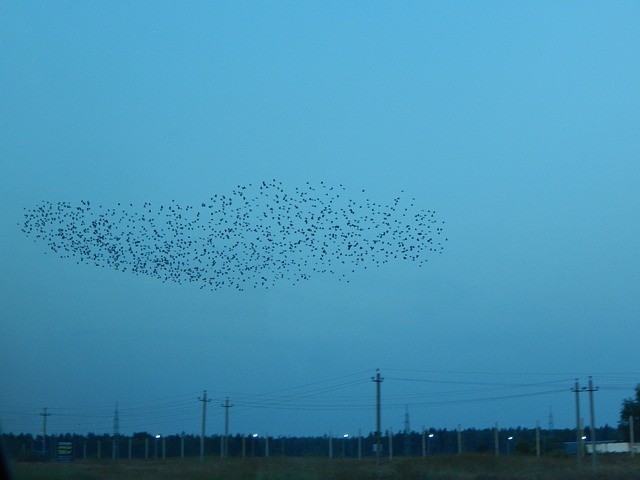
Compared to other common birds, like robins and grackles, starlings are less likely to place plant matter at the top of their menu, assuming there are enough insects to satisfy them.
Nutrition
It makes sense that these feisty birds prefer bugs. They are just the right size for easy consumption, are numerous enough to sate the flock, and have a comprehensive nutrient profile.
Insects are great sources of protein, on par with chicken for calorific yield by weight. They have a blend of saturated and unsaturated fats, useful for energy and crucial in winter months.
The nutritional values of insects and other invertebrates vary largely across species.
However, the starling eats a variety of these creatures, so it gets a balanced diet of all their potential offerings.
List of Vitamins & Minerals Starlings Get From Insects
- Vitamins, A, B-6, B-12, C, D, E & K
- Calcium
- Iron
- Potassium
- Copper
- Manganese
- Magnesium
- Phosphorus
- Selenium
- Zinc
Insects also contain all the essential amino acids and both omega-3 and omega-6 fatty acids.
Those with a chitin carapace, like crickets, are also a source of chitosan, a sugar that helps to regulate cholesterol and manage weight.
Fruits & Berries
As much as they love bugs, adult starlings love battling noisily over an apple or other types of fruit. They have no qualms about pecking away at a juicy, or dried, sweet repast.

Even the young starlings will add a few berries to their insect-laden plates from time to time, making up about 5% of their diet during the early Autumn.
What Fruit & Berries do Starlings Eat?
Starlings will eat any of the fruit and berries in this list below and more…
- Apples
- Pears
- Figs
- Concord Grapes
- Raisins
- Plums
- Oranges
- Elderberries
- Blueberries
- Blackberries
- Mulberries
Because of their slender beaks, starlings can’t exactly take a bite through the tough skin. If you’re feeding them, try cutting the fruit into slices, or, better yet, bite-sized morsels.
However, these resourceful birds have their own method of attack for whole fruits. They stab through the skin and eat the softer flesh through the small opening thus created.
Nutrition
Fruits and berries offer starlings many vital nutrients that may not be present in their insect prey.
They also provide a quick energy boost thanks to their fructose content, which can be a useful contrast to the slower energy gained from bugs in the form of fat.
Once again, the starling’s diverse tastes serve it well. These iridescent avians eat many different fruits, they have a better chance of ingesting their full array of vitamins and minerals.
List of Vitamins & Minerals That Starlings Eat:
- Vitamins A, B-6, B-9, C, & K
- Potassium
- Fibre
- Iron
- Magnesium
- Calcium
Both fruits and berries contain numerous antioxidants, with excellent health benefits.
For instance, quercetin reduces inflammation and fights cancer. Catechin boosts a bird’s mental acuity and muscle function. And, fresh fruits help starlings remain hydrated.
Dried fruits are better sources of iron than their fresh counterparts, the mineral necessary to prevent hyperkeratosis in starlings, which can deform their feet, feathers, and beak.
Seeds, Grains, Nuts, & Legumes
Adult starlings rely on seeds and similar feed for a significant portion of their nutrition.
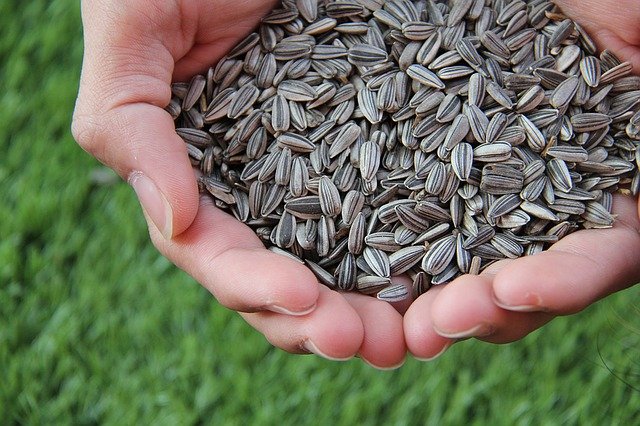
With flocks that reach into the tens of thousands, the reliable food source of a grain field, or a yard decked with convenient feeders, can’t be overvalued
Grains
Farmers tend to harbour ill will towards the starling, thanks to the devastation their large flocks can wreak on a harvest.
These birds are well aware of the harvest schedule and tend to take up residence in the vicinity of fields that can feed them.
What Types of Grain do Starlings Eat?
- Wheat
- Oats
- Rice
- Cracked Corn
- Barley
- Rye
- Millet
Milo, or sorghum, is too large and hard to be safe for starlings, as are whole corn kernels. Only feed cracked corn to a starling, otherwise, it may attempt to eat the whole kernel and choke.
Also, only serve raw oats. The cooked version can harden in or around the birds narrow beak, blocking their airway or causing them to starve.
Seeds, Nuts & Legumes
A starling’s bill is neither tough nor strong enough to break through all but the thinnest shells. For this reason, they will pass over unshelled seeds the majority of the time.
However, they are eager eaters of the crumbly, nutrient-rich kernels within the shells. All of the following sit at the top of the pecking order, provided they are served sans shell:
What Seeds, Nuts and Legumes do Starlings Eat?
Starlings will eat a variety of seeds, nuts and legumes but here are their favourites…
- Peanuts
- Almonds
- Pecans
- Cashews
- Sunflower Seeds
- Pistachios
- Walnuts
It’s a good idea to break the nuts down to small pieces as well, as even shelled nuts can be troublesome for this bird if they are too large.
Nutrition
All of the foods in this category are ultimately seeds, packed with the nutritional blueprint that will allow them to grow into a full-sized plant.
That means they are great sources of a variety of ingredients essential to all living things, starlings included.
Of particular interest to this bird are the fatty oils present in things like peanuts and black oil sunflower seeds. It’s a prime source of energy, but oils keep the feathers sleek, shiny, and healthy.
Protein is another sought after nutrient provided by this category.
List of Nutrition, Vitamins & Minerals in Seeds, Nuts & Legumes:
- Carbohydrates
- Fibre
- Vitamins A, B-6, B-7, B-12, & C
- Calcium
- Iron
- Folate
- Magnesium
- Manganese
- Potassium
Vegetables & Leafy Greens
Starlings may not be the birds most likely to damage food crops and gardens, but that’s poor consolation for the gardener whose plants have been picked apart by a massive flock.
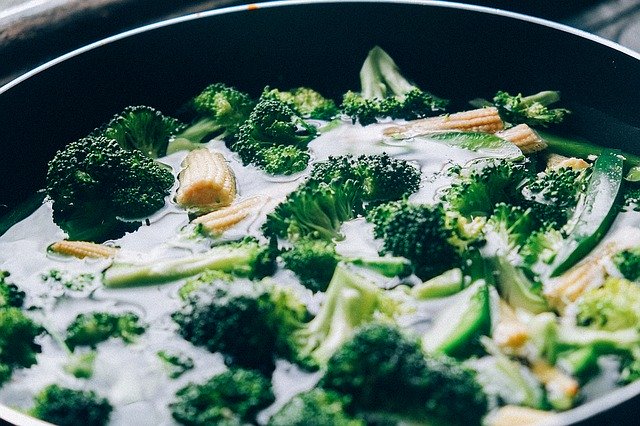
These passerines can and do eat veggies and the leafy greens of many plants.
What Vegetables and Leafy Greens do Starlings Eat?
Starlings have a wide range of veg and greens in their diet, here are some of them…
- Sweet Potatoes
- Carrots
- Beets
- Turnips
- Squash
- Broccoli
- Corn
- Peas
Starlings will eat the leaves of all these plants as well. Root vegetables are not generally dug up, and things like carrots and turnips are tough enough when raw to be unappealing.
Starlings love them when cooked. The greens of the plants above are far from the only ones these birds will make a salad of. T
What Vegetables & Plants do Starlings Eat?
As with most birds, starlings love to eat veggies and plants but here are a few of their favourites…
- Snapdragons
- Cosmos
- Dahlias
- Sage
- Dandelions
- Cabbage
- Mustard Greens
- Lettuce
- Spinach
- Kale
In the wild, they will take their pick, but if you are feeding a starling in your garden make sure to wash the greens thoroughly in case of pesticides before serving.
Nutrition
Vegetables offer as many health benefits to starlings as they do to humans.
They are among the most nutrient-dense foods, filled with amino acids, flavonoids, and an array of vitamins and minerals, including:
List of Vitamins & Minerals in Veg & Plants:
- Vitamins A, B-6, B-12, C, E, & K
- Riboflavin
- Folate
- Thiamin
- Niacin
- Biotin
- Pantothenic acid
- Calcium
- Magnesium
- Potassium
- Iodine
- Carbohydrates
- Fibre
What they are lacking, however, are protein and calorific yield. Vegetables have no meaningful fat content, and are low in carbs — and much of that is insoluble fibre.
They make for healthy supplements to a starlings diet, but these birds could never survive on too many plates of greens.
Processed Foods
One of the reasons starlings are able to thrive in non-native environments is their willingness to eat human foods. This opens up a whole world of options for them.
Urban starlings rely on landfill and rubbish bins as reliable sources of victuals.

On top of that, many people who feed birds only on occasion do so by tossing out stale bread or other leftovers that might otherwise end up in the trash.
While this represents a noble sentiment, not everything we eat is for the birds.
What Human Foods do Starlings Eat?
You’ll often see starlings pecking away at human foods but here are a few of their preferred choices…
- Bread
- Chips, or French Fries
- Pasta
- Crackers
- Dog & Cat Food
- Processed Meats
- Eggs, Cooked or Dried
- Applesauce
- Dried Fruits
- Nut Butter
- Laying Mash
In fact, a mixture of cat food, applesauce, egg powder, and laying mash (a type of chicken feed) is recommended as the ideal feed for starlings in your garden.
It’s easier to ensure your bird receives all the nutrients it requires, at the proper levels, when the amounts are listed on the packaging.
Nutrition
The ingredients in a given processed food item can be completely different from another item in the same category.
Bread and bologna are both processed, but whereas one is mostly empty carbs and a smattering of vitamins, the other contains nitrates, sodium, fat, and protein.
In general, processed foods contain more sodium and sugar than is healthy for starlings, and far fewer vitamins, minerals, and essential compounds than whole foods.
That said, some nourishment is better than none.
If you feed starlings, particularly in the winter when they may be struggling to find enough food, prioritize things like;
- fortified pasta (raw or cooked without seasoning)
- unsalted chips
- nut butter with no added sugar.
What do Baby Starlings Eat?
Starling chicks eat only insects. While mom and dad might eat anything from huckleberries to old chips from the garbage, they only feed their children the best.
They instinctually know that bugs contain the ideal balance of nutrients, particularly protein, required for their babies to have the best chance of survival.
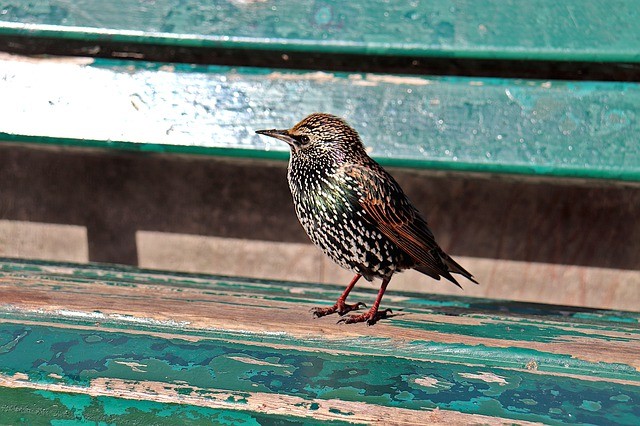
Captive starling fledgelings are fed on the processed food mixture mentioned in the previous section. Cat food should have at least a 30% protein content, and about 10% fat.
Besides the applesauce, eggs, and laying mash, avian vitamins should also be included to guarantee the chicks get everything they require.
Conclusion
Starlings occupy an awkward place among birds. They are often considered to be a pest and yet are often sought after as pets. They are instrumental in keeping the insect population down but are often vilified for eating what makes up less than half of their diet.
The truth is that this expert mimics, sporting plumage with an almost metallic sheen, are resourceful, adaptable survivors. And, for all the problems that they can cause, if they were gone, we would all be the worse off for it.
F.A.Q.s — Popular Starling Diet Searches
What Do Starlings Eat In The Lawn?
Lawn grubs are the primary target, with earthworms, beetles, and sundry other insects rounding out the list.
The term “lawn grub” encompasses a variety of insect larvae, which are among the best sources of protein among bugs.
Starlings hunt for them using a process called “probing,” where they stab their sharp beaks into a likely spot in the soil and hope to hit a meal.
However, if they aren’t hunting insects in your yard, they may be snacking on the leaves of dandelions or other plants there.
Do Starlings Eat Baby Birds?
Yes, sometimes starlings do eat baby birds. As omnivores, they’re able to gain sustenance from baby birds and other small vertebrates, though this is not their preference.
However, if you see starlings raiding another bird’s nest, it’s more likely for a different, though no less deadly, reason.
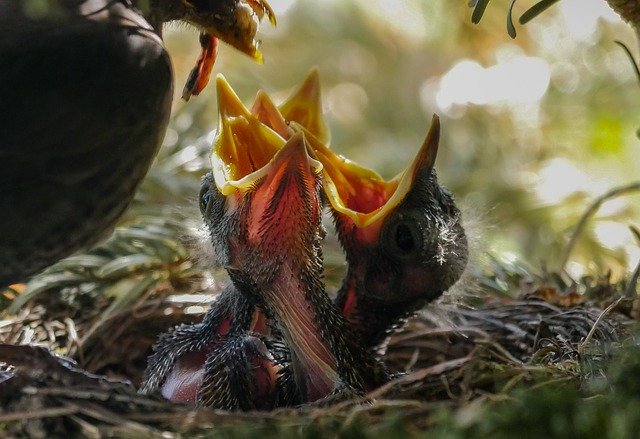
When the male starling is searching for a place to build a nest, he’s not inclined to pass up the perfect spot just because another bird is already using it.
Starlings routinely break and cast out the eggs of other birds, and will also kill and discard any living chicks. It is a ruthless way to make room for a potential family of their own.
Do Starlings Eat Mealworms?
Yes, starlings do eat mealworms.
Mealworms are insects and placing them squarely in the category most palatable to this bird, especially when they are young. Mealworms are a better than average choice nutritionally.

Compared to crickets, they are higher in protein, fat, and nitrogen-free extract. Starlings flock to feeders where mealworms are offered and enjoy them whether fresh or dried.
What do Starlings Like to Eat the Best?
Larvae. You already know that starlings prefer insects and invertebrates, and they love them in their larval form most of all.
It makes sense. As ground feeders, with beaks ideally suited for probing the soil and nooks and crannies, starlings are practically made for hunting these plump morsels.
Larvae are slow-moving, making them easy to capture. They have no carapace, making them just as easy to eat. And, they are rich in exactly the kinds of nutrients starlings desire.
Can Starlings Eat Bananas?
Yes, starlings can eat banana and they seem to enjoy them heartily. The soft flesh and its high sugar content provide a near-instant shot of energy to the bird’s high-speed metabolism.
The thick peel should be removed.

Starlings can perforate it, but it’s extra work and makes it difficult for them to get the most from the fruit, especially that they will lose interest in it once it has become too mushy.
With that in mind, only put out as much of this fruit as you expect will be eaten in a sitting. Leftovers will only go bad and attract pests if they are outside.